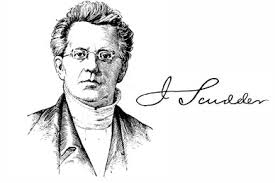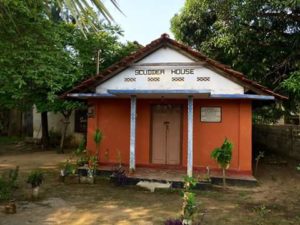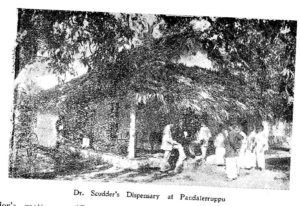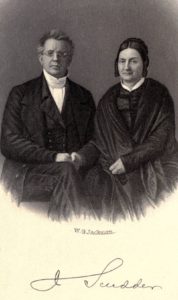Dr. John Scudder and the First Western Medical Centre in South Asia
By Dr. D.C. Ambalavanar, Visiting Lecturer in Surgery, Faculty of Medicine, Jaffna, October 29, 2017
 On October 18th a public function was held by the Church of the American Ceylon Mission in the village of Pandatherippu in Northern Sri Lanka. This was the final event of several held over the past year to celebrate and commemorate the arrival of the first American missionaries to Jaffna in October 1816. During this function which was attended by public officials, members of the medical profession and church members, a postage stamp and first day cover honoring Dr. John Scudder was officially released by the Sri Lankan Postal Department.
On October 18th a public function was held by the Church of the American Ceylon Mission in the village of Pandatherippu in Northern Sri Lanka. This was the final event of several held over the past year to celebrate and commemorate the arrival of the first American missionaries to Jaffna in October 1816. During this function which was attended by public officials, members of the medical profession and church members, a postage stamp and first day cover honoring Dr. John Scudder was officially released by the Sri Lankan Postal Department.
Who was this John Scudder who was being so singularly honored by a community and country so far from his own? What had brought him thousands of miles to this little village in Jaffna? His story begins on 3 September 1793 in Freehold in New Jersey in the fledgling nation of the United States of America where he was born. He graduated from Princeton University in 1811, and the New York College of Physicians and Surgeons in 1813. He practiced successfully in New York City in the early stages of his career earning a very good income. The path in life that individuals set out on is often not what they had envisaged for themselves and a dramatic change may be often brought about by chance. It was just such an occurrence that resulted in thousands of people in two faraway lands benefiting from the teaching and healing prowess of this man and his descendants.

Scudder House at present
One night while visiting a patient in New York, John Scudder’s attention was caught by the title of a pamphlet lying on the table. “The conversion of the world or the claims of 600,000,000 and the Ability and Duty of the Churches Respecting Them”. As he read through it the thought came to him, “Why doesn’t someone do something about this?” He asked himself, and immediately the reply flashed into his mind; “Why shouldn’t I?” He felt he was being called upon to “Go heal the sick and preach the Gospel to those who have never heard of Christ”. He was 25 years old then.
After consulting his wife Harriet Scudder, he approached the American Board of Commissioners of Foreign Missions and offered to be sent out as a missionary. The opportunity he asked for was to serve as both physician and minister in a land where there was none of the former and few of the latter. It was a unique undertaking. Unfortunately John’s father Joseph Scudder could not reconcile himself to this decision and disinherited him when he left.
At the age of 26 Dr. John Scudder accompanied by his wife Harriet, three year old daughter Maria and their maid Amy embarked on the ship ‘Indus’ at Boston docks on a journey that was to alter the destiny of thousands in two very distant lands. The American Board of Commissioners for Foreign Missions was sending forth the first American Medical Missionary (and one of the first from the western world) on a missionary endeavor.
After four months at sea they made land in Calcutta in India where his daughter Maria died tragically from dysentery. They then set out for Ceylon and arrived in the island in December 1819 where they were assigned to work in the Tamil region of Jaffna. The death of Maria was not to be the last of their travails for a second daughter who was born in Jaffna died soon after birth. Lesser people would have probably given up at this point and got on the next ship home but these pioneering missionaries were made of sterner stuff and were fully imbued with the spirit of service. In John Scudder’s words,’’ This is a severe trial, but we do not repine. We must say that our trials have been heartrending…….Perhaps our dear parents may be ready to say that we are sorry and repent of our coming. No, we rejoice and thank the great Head of the church for putting it into our hearts to leave America and come and live among this people. I would not exchange situations for a world.’’ A son born in 1820 was to die shortly after birth. (All in all they had 13 children of whom 3 died as babies and one by drowning).
Pandatherippu

In July 1820 the Scudders opened a new missionary station in the little village of Pandatherippu. Like the other missionaries he took it upon himself to learn Tamil which could not have been easy. He saw his primary purpose to be that of sharing the Christian message. He found the healing ministry as a way by which he could make the ‘natives’ more open to that message. He was an astute observer of the locals and their customs. Some of his highly critical observations might not be considered acceptable in today’s world but were made in the context of his times and his missionary zeal. One of the priorities of the missionaries was in education which was sorely lacking among the locals. Dr. Scudder and his wife were also involved in this work. They did not restrict this just to the males but also brought education to the females who they thought were particularly oppressed. They looked after up to forty children in their home, most of who were orphans. His observations about women will still strike a chord in patriarchal societies.
As the ABCFM had not sent enough funds, John Scudder drew on his own to set up a school and hospital/clinic in Pandatherippu. He started the first medical service of its kind for the public in the island here. The government had given permission for the Scudders to live in an old bungalow with a thatch roof. The adjoining old Portuguese church which was in ruins was restored and he was the first to be in charge as its minister. The Scudders started two schools in the village, one for boys and the other for girls. All in all, John Scudder helped to establish twenty-five schools in Jaffna.
Medical work
 The medicine practiced in Jaffna in the days before the arrival of John Scudder was based on the ‘Siddha’ medicine practiced in India. Without the patronage of the royal household of the King of Jaffna the standards of such ‘native medicine’ had suffered. In the midst of widespread ignorance and superstition John Scudder undertook his medical work. He treated all kinds of ailments in his little bungalow, whose original room still exists as part of the present priest’s residence and is known as Scudder House.
The medicine practiced in Jaffna in the days before the arrival of John Scudder was based on the ‘Siddha’ medicine practiced in India. Without the patronage of the royal household of the King of Jaffna the standards of such ‘native medicine’ had suffered. In the midst of widespread ignorance and superstition John Scudder undertook his medical work. He treated all kinds of ailments in his little bungalow, whose original room still exists as part of the present priest’s residence and is known as Scudder House.
Picture if you will the scene of those days. Men, women and children, squatting in their familiar way on the ground. Before he treats them he first comes out to them, opens his Bible, and gives them a short and inspiring talk. Then, one by one they are called into his sanctum. We see the crippled men, the women weary and worn, the pale and sick children; we note the strong and yet anxious friends that have brought them; there they stand, or squat, or lie, patiently waiting their turn to see this foreign man who has the power to heal. It is a scene that any painter might delight to draw.
Scudder dealt with many diseases including outbreaks of cholera. His surgical skills were particularly in demand. In his memoirs he describes ‘Wednesday, January 10th. This morning I removed a tumor from the side of a man which measured more than one foot in circumference. It was the largest I ever took out.’ He describes again how he used an eight inch incision on the back of a twelve year old girl to remove two tumours while all the while the girl swore shockingly and profusely at him during the procedure in those pre-anaesthesia days!
He treated broken bones and open wounds. Among the other procedures he carried out was cataract surgery of which he did many. He describes how, ‘I performed the operation for cataract on an old man above seventy years of age, and succeeded in restoring his sight to him.’ Those of us who carry out similar operations and procedures in our modern hospitals and clinics can only be in awe of the skills and abilities that enabled him to perform such procedures in those far off days in Jaffna.
John Scudder’s healing and preaching was not confined only to Pandatherippu but to the whole peninsula as well as some of the adjoining islands. He would undertake difficult travels through wild uninhabited areas to take his message and healing skills to the people of the land.
In times of epidemics, especially cholera, he and Harriet would administer to the sick, bathing them and burying the dead and doing what they could to relieve their distress.
In the words of his biographer, ‘Dr. Scudder’s twofold work as physician to the body and soul, while it gave him the greater influence, imposed upon him unusual labors. He carried along with him medicines and surgical instruments, that he might be ready to meet every case of bodily distress, believing in this way God opened avenues to the soul.’ John Scudder was convinced that medicine was a means to an end. The body was healed so that the soul could be saved.
In this work he had the full support and help of his wife Harriet who bore the responsibilities of being a mother to their own children in addition to those many they had adopted and kept with them in their home. The help they received from Amy, their colored maid was invaluable. Amy may well have been the first Afro-American to come to Jaffna.
The Scudders underwent many hardships and challenges. They had thirteen children of whom, after Maria, two were to die in infancy and another of drowning. However, they were able to overcome these difficulties through their strong conviction that they were doing God’s work.
Scudders move to India
In 1836 the American Board asked the Scudders to go to Madras to continue his work in the northern part of what is now Tamil Nadu state as the East India Company was now permitting missionaries to work in India.
Dr. Scudder and his family were to continue the work that they had first begun in Jaffna. They left a legacy that was to long outlive them. All nine of their surviving children, of whom five were doctors, were to serve as missionaries in South India. His granddaughter was Dr. Ida Scudder who founded the internationally famous Christian Medical College and Hospital in Vellore. In many ways her achievements were a fulfillment of his vision. Forty two Scudders in all have given a combined service of one thousand and a hundred years to India, the land they adopted. John Scudder was the patriarchal figure who provided the inspiration and vision for others to follow where he had trod.
It is only fitting that the first ever American Medical Missionary should be honored and remembered in Jaffna by the same community whose people he and his family served nearly two hundred years ago with such faith and dedication.
Dr. John Scudder, Sr. – Missionary, evangelist, healer and teacher
References
Waterbury, J.B. Memoir of the Rev. John Scudder, M.D. New York: Harper, 1870.
From Mission to Church: The Reformed Church in America Mission to India By Eugene P. Heideman
Scudder, John. Dr. Scudder’s Tales for Little Readers, about the Heathen. New York: American Tract Society, 1849.
Scudder, John. A Voice from the East to the Youth: in a Series of Letters to the Children of the Reformed Protestant Dutch Church of North America. New York: Board of Publication of the Reformed Protestant Dutch Church, 1859
[…] Ambalavanar, courtesy of Tamilsangam, where the original title is “From New Jersey to Pandatherippu. Dr. John Scudder and the […]
It’s worth noting the euphemistic and watered down narration of the life of this man by this author, who, though founded schools in Jaffna, was ultimately still a white christian colonizer with a civilizing agenda. Also, Amy was not their maid, she was a slave. Her help being invaluable was because she was a slave, in which of course she was invaluable, because her colonizing masters would be nothing without her doing dangerous and exhaustive work. Slavery in the US, was legally abolished in 1865.